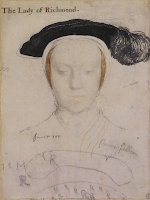Remembering Anne Boleyn: Reminisces of Mary Howard & the Devonshire group by Sylvia Barbara Soberton
Happy Sunday! I'm delighted to announce that today we have a guest post by Sylvia Barbara Soberton, author of the best-selling book entitled The Forgotten Tudor Women.
Over to Sylvia . . .
In my book, The Forgotten Tudor Women, I explore the tumultuous lives of three courageous women: Margaret Douglas, Mary Howard and Mary Shelton. These three women all started their careers at court as maids of honour to Henry VIII’s second wife, Anne Boleyn.
 |
| Anne Boleyn |
 |
| Mary Howard |
Anne Boleyn’s tenure as Queen came to an abrupt end in May 1536 when she was arrested and executed. Henry VIII remarried eleven days after his wife’s judicial murder, and it seemed that life at court went on as normal. Behind the closed doors, however, some people gave vent to their despair. Thomas Wyatt, the poet who was imprisoned as Anne’s alleged lover but later cleared of charges and released, wrote a heartbreaking poem where he recorded:
“I was made a filling instrument
To frame other, while I was beguiled”.[2]
Thomas Wyatt’s biographer, Nicola Shulman, explained that Wyatt was a “filling instrument” in the sense of betraying or defiling the honour of other people, presumably those who died with the Queen. The fact that Wyatt was romantically linked with Anne Boleyn in the past answers the question of why he was imprisoned in May 1536 but doesn’t offer an explanation as to why he was released. Thomas Cromwell rewarded Wyatt with a large sum of £100 in May 1536, a date implicating the poet may have been interrogated and coerced into providing damning details about Anne Boleyn’s circle. Whatever he confessed to the authorities, it is clear that Wyatt felt guilty. His poem was copied into the Devonshire Manuscript, a courtly anthology strongly associated with Mary Howard, Margaret Douglas and Mary Shelton, who were among its most prominent contributors. Did they feel the same? Were they forced to testify against their royal mistress? It seems highly likely because Thomas Cromwell later claimed that Anne Boleyn’s ladies-in-waiting provided damning details, and three of her serving women—Elizabeth Somerset, Countess of Worcester, Nan Cobham and one other unnamed maid—were mentioned in contemporary correspondence as the Queen’s accusers.
 |
| John Foxe |
 |
| Mary Howard's handwriting |
Foxe’s book also contains a rich description of Princess Elizabeth’s christening on 10 September 1533, and this event was most likely related to him by Mary Howard, who carried a rich chrism of pearl and stone. The fact that Mary Howard kept these memories alive proves that she cherished them, and perhaps Mary’s early religious views were shaped by Anne Boleyn’s religious tendencies. Mary had not only sheltered the Protestant John Foxe, but also read the Bible in the vernacular and enjoyed debating its contents with like-minded individuals so much so that her elder brother, the Earl of Surrey, warned her about “going too far in reading the Scripture”.[5] Anne Boleyn had famously encouraged her ladies to read the New Testament translated by William Tyndale, which she held wide open at her desk, and it is possible that Mary began to develop her own religious views under Anne’s wing.
Mary left court, probably in the summer of 1536, and did not join the household of Henry VIII’s new wife, Jane Seymour. It may be that Mary voluntarily shunned court after Anne’s execution, although the arrest of her half uncle, Thomas Howard, and the death of her young husband, Henry Fitzroy, in the summer of 1536 certainly influenced her decision.
[1] John Foxe, Book of Martyrs: The Actes and Monuments of the Church, Volume 2, p. 372.
[2] Nicola Shulman, Graven with Diamonds, p. 195.
[3] Letters and Papers, Volume 10, n. 601.
[4] John Foxe, Book of Martyrs: The Actes and Monuments of the Church, Volume 2, p. 372.
[5] Letters and Papers, Volume 21 Part 1, n. 769.

No comments:
Post a Comment